Having just arrived from Dubai, we were suddenly thrown into a completely different world. One moment it was luxury, splendor, glitz, and superlatives – now it was noise, chaos, poverty, stench, and simplicity. In our eyes, the area around Colombo is more for backpackers than package holidaymakers. Sri Lanka, the “Teardrop of India,” is an island nation located about 30 km from the city of Kanyakumari, which lies on the southeastern tip of India.
Here in Sri Lanka, around 21 million people live on an area of approximately 65,610 km². From north to south, it is just under 450 kilometers, and from east to west, only 22.5 kilometers. So the island isn’t as big as we thought it would be. Until 1972, the island was called “Ceylon” because of the export and cultivation of Ceylon tea. Rubber, coffee, and coconuts are also among the most important products.
70.2 percent of Sri Lanka’s population are Buddhists, 12.6 percent Hindus, 9.7 percent Muslims, and 7.4 percent Christians. Sri Lanka’s climate is tropical with varying rainfall patterns due to the monsoons. Traffic is chaotic and dominated by tuk-tuks, cars, and buses. Today, however, there is also a rail network connecting the most important cities in Sri Lanka. The total length of the rail network is 11,000 kilometers (Sri Lanka State Railways).
1. No idea about the exchange rate?
We landed in Colombo, didn’t have a cent in our pockets, and went to the nearest ATM at the airport to withdraw some money. However, we didn’t have the slightest idea what the exchange rate was. So what should we withdraw? 1,000 LKR, 5,000 LKR, or perhaps 10,000 LKR?

The currency in Sri Lanka is called the rupee – there are notes of 10, 20, 50, 100, 500, 1,000, 2,000, and 5,000 rupees, and coins of 1, 2, 5, and 10 rupees. Eventually, we found a kind of exchange office and were able to check the table to see what we could get for one euro. In the end, it was 152 LKR for one euro. So we exchanged €50.
2. Tuk Tuks in Sri Lanka
Everyone knows them – the small three-wheelers, called tuk tuks, or auto rickshaws. They are a widespread type of taxi in countries like India, Pakistan, Bangladesh, Thailand, Sri Lanka, Laos, and other Asian countries. Loud honking, jostling, and rattling engines are heard everywhere. The streets stink, and everyone drives as they please – wherever there’s a few centimeters of space. You can squeeze between cars, buses, and bicycles and make your way through the traffic jungle (note: left-hand traffic!).
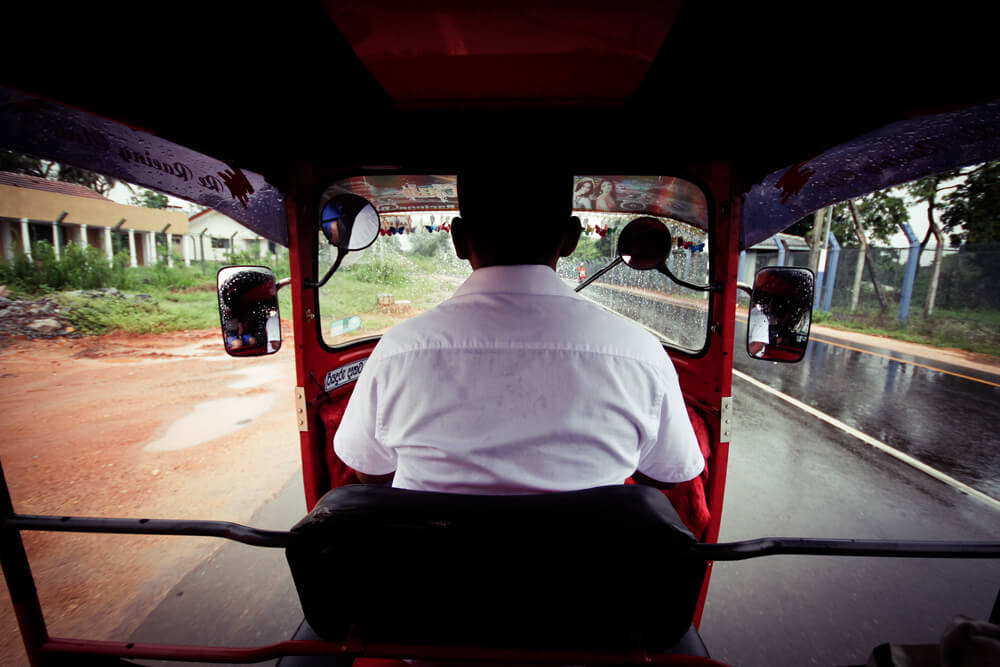
In comparison, tuk tuks are a super cheap way to get around here in Sri Lanka. Prices fell sharply in 2015 because the government made gasoline about 30% cheaper. In Colombo, prices are set by the government. The first kilometer costs 50 LKR. Each additional kilometer costs 30 LKR. You can get these prices in so-called “meter taxis.” At the airport, for example, we paid almost 500 LKR for 1 kilometer, but only 200 LKR on the way back. You definitely have to bargain. The drivers will also tell you that your hotel is 6-8 kilometers away, even though it’s just around the corner.
3. Transfer bus from the airport to Colombo
Bandaranaike International Airport is located just under 32 kilometers from Colombo city center. It’s only about 10 kilometers from here to Negombo. The cheapest way to get to Colombo city center from the airport is by bus 187 (don’t take the city bus 187, but the coach). This bus leaves directly in front of the airport exit terminal.
Otherwise, there are many, many taxis, cars, and tuk tuks buzzing around, all of which would be happy to give you a ride^^. They’ll easily charge you 1,000-2,000 LKR (rupees). The bus, on the other hand, only takes about an hour (if it’s on the highway, otherwise it’s 2 hours on city bus 187 – super annoying!) and costs around 100-120 LKR per person (less than €1). The other drivers will also try to convince you that the bus starts 1-2 kilometers away (they want to drive you around in circles a few more times to make money).
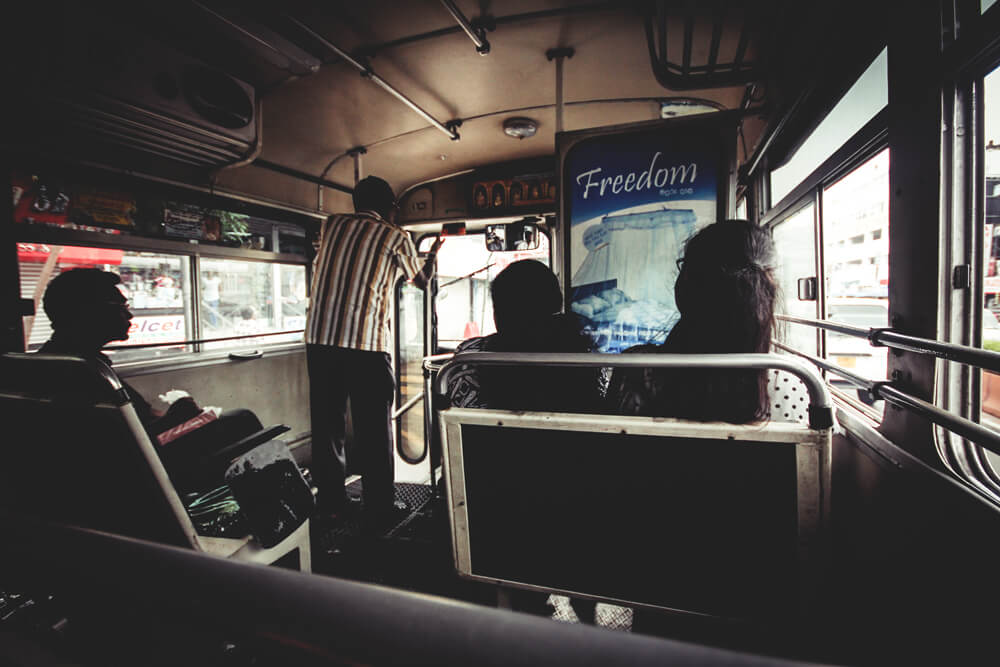
Bullshit! The bus (an old, rickety coach) starts right in front of the terminal. If you ask police officers or airport employees, they’ll usually show you the way and won’t hesitate to steer you around. Everyone else is trying to rip you off (at least, that’s how it was with us) – so be careful! You buy tickets directly on the bus. At some point, a man on the bus will start collecting money from all the passengers. So just get on and drive off (the bus ends at the “central station” in Colombo).
4. Public Buses in the City
If you don’t feel like taking a tuk-tuk, you can also get from A to B cheaply in the city with the many buses. There are countless bus numbers that travel up and down the streets all day long. As soon as a bus stops somewhere, you can hop on. You can also get off the same way.

The doors are never closed and in the evening it can get very cramped and cozy, because then the buses are often overcrowded. At some point during the trip, the “money collector” comes along—sometimes he wants 10 rupees, sometimes 25. When we didn’t take a tuk-tuk, we used the buses, because it really couldn’t be cheaper (20 rupees = 13 cents).
5. Don’t leave your shoes outside a temple!
If you visit a temple in Colombo, you’ll usually have to take off your shoes and leave them there. Please make sure you’re not wearing your best sneakers that day. Marco’s Nikes were promptly stolen. It was very unpleasant and not exactly the best start to his day of sightseeing! Especially since he then had to walk barefoot through the city until we could buy flip-flops for just under €2. Nobody had touched my flip-flops outside the temple.

And while we’re on the subject: in sacred buildings, you should cover your shoulders and knees and not wear a hat or anything similar out of respect! They even charge non-locals up to 200 rupees for entry! Everyone else is probably a temple member and doesn’t have to pay.
The Gangaramaya Temple is probably the most famous temple and pretty much the only “highlight” – especially since it also seems like a hodgepodge of knick-knacks. Kitschy figures, artificial flowers, kind of weird. But it’s worth a look. Here in the picture you can see the “Seema Malaka complex”, which is located near Gangaramaya.
6. Sri Lanka Visa on Arrival
When you land in Colombo and head towards the airport exit, you will soon come to a counter for a “Visa on Arrival“. This means that you will receive a visa upon entry and can stay here for up to 4 weeks (important: your passport must be valid for at least 6 months!).

You will receive a document on the plane which you must fill out. You will then hand this in at this counter. The whole thing will cost you 35 US dollars (approximately 31€) and can be paid with a Santander credit card or Payments can also be made with other credit cards. Then, you go through the security check with your passport.
7. Shopping at the Supermarket
Here, you can get almost all the essentials, such as eggs, milk, bread, fruit, drinks, and the like. The most common supermarkets we saw here were Aprico, Keelss Super, Fruit City, and Laugfs. Depending on the product, prices can be cheap or relatively expensive. Especially if you’re craving Western products, you’ll have to dig deep into your pockets (Nutelle mini jar €4, Kellogg’s Cornflakes €3).

You can get a loaf of toast for just under 80 cents, and a bottle of water 1.5L for 50 cents, eggs (10 pieces) for €1.30, milk for 50 cents, or drinks for under €1. So, you can start shopping for super cheap, but you can also pay more sometimes. In general, however, we found the products to be relatively expensive.
Our shopping was always between €3 and sometimes €15 – depending on what we needed. However, if we didn’t have to buy anything specific, we managed with very little money per day. I personally find that it always smells quite strange in the shops – a kind of mix of chlorine, old fruit, and rotten meat. But you get used to it – don’t worry!
8. Street Food in Colombo
Food is very important to the Sinhalese; they eat hot meals three times a day – almost always rice and curry. Curry is not the spice mixture we know, but a meat or vegetable sauce based on coconut milk. Whether it’s vegetable curry, fish, or Chicken curry – there are many variations here.
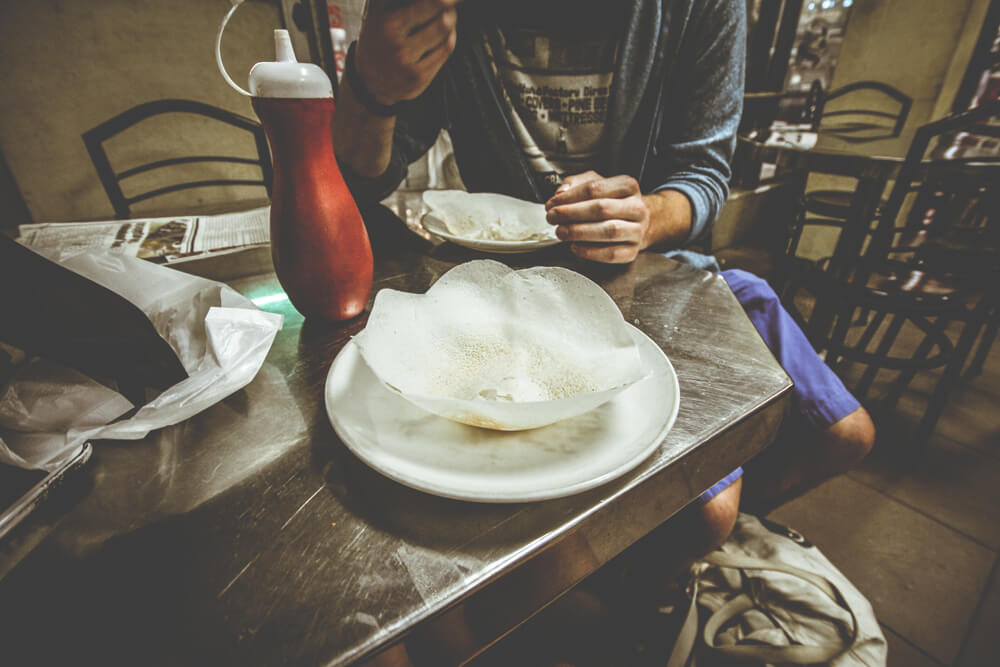
You’ll also often find filled dumplings with fish, vegetables, or chicken (also called egg rolls and chicken rolls). In the evening, you can get milk hoppers (semi-circular batter, often with a fried egg in the middle) with or without curry. These things taste somewhat like nothing, but somehow also good.
You only pay 20 LKR per hopper, or 40 LKR with a fried egg in the middle. There are also string hoppers, which are made from rice noodles. You’ll also find various versions of “kothu roti” on almost every corner. Whether it’s egg roti, vegetable roti, or coconut roti, the dough looks like a pancake and is filled with vegetables, egg, or some other paste. Oh, and if you eat without cutlery, you’ll have to use your right hand!
9. A city map would be ideal
If this is your first time in Colombo, you should have a city map. Google Maps would suffice, but it’s a shame there’s never any Wi-Fi here. We had absolutely no idea where we were, how to get to the next point, or where certain sights in the city were located.
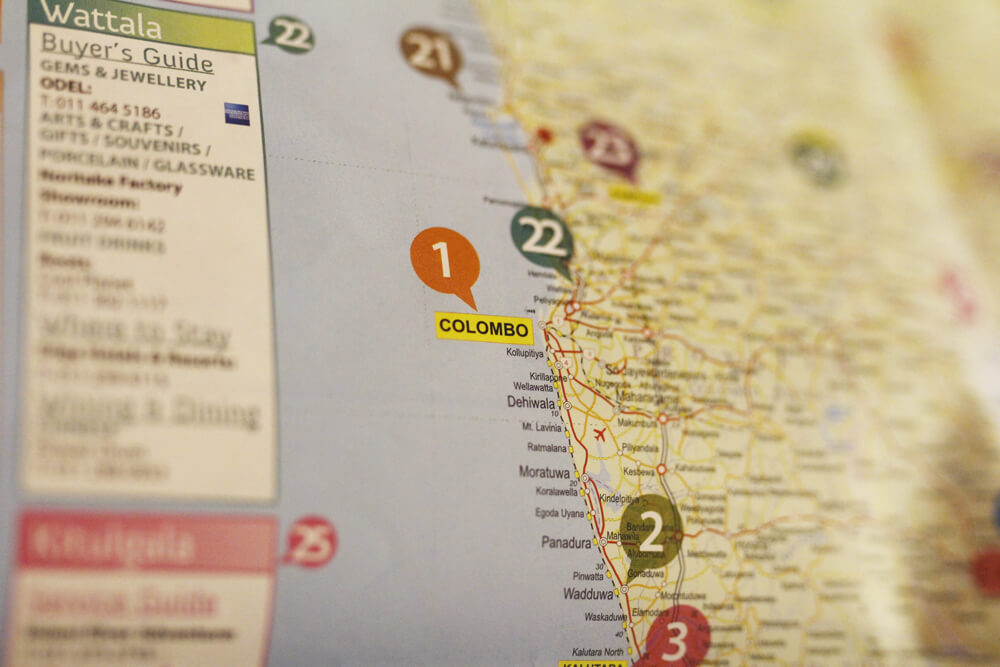
Somehow, we often just set off without a plan and often had to ask around and fight our way through the jungle. Okay, it worked out that way! But having an overview of the city is highly recommended.
10. Book accommodations!
We booked our accommodations via booking.com or Airbnb. Booking.com offers a huge selection of hotels, hostels, and guesthouses. However, you have to keep in mind that you have to pay an additional 25% of the booked price on site. However, we can absolutely recommend theFair View Hotel.
It’s located in Colombo 6 and opened just two months ago. Of course, the price of €128 (2 nights, 2 people, breakfast) was quite expensive, but we wanted to treat ourselves for the first few days. We had a sea view, a super modern, quiet, and beautifully furnished room.
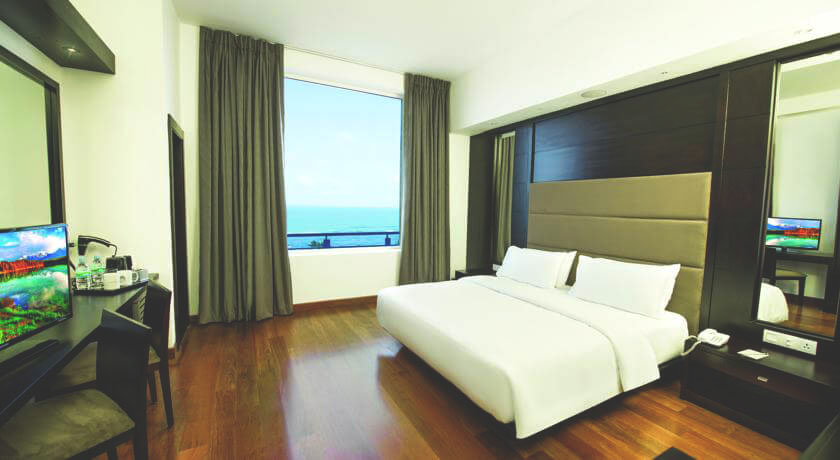
For the remaining nights, we looked on Airbnb. Here we found a cute place to stay in Mount Lavinia. I made the booking immediately, and a minute later we received confirmation from Benjamin, the landlord. So we set off by tuk-tuk and reached our apartment without any problems.
The parents and family members live downstairs, and we live upstairs. We have a terrace with a kitchenette, a nice, clean room, a modern bathroom with a glass roof over the shower (sky view), a TV, air conditioning, a refrigerator, and some seating. We paid a total of €63 on Airbnb for 2 nights.
You can often find voucher codes online that you can use for your booking. We’ll give you €23 straight away if you sign up with Airbnb. Simply follow this link (register and save €23)! Overall, accommodations can of course be found much cheaper, but we simply didn’t dare go to some places, or we didn’t want to stay in some dump. The standard is completely different here.
11. Holidays and Street Festivals
Don’t be surprised if the streets get a bit louder (can it get any louder?). The Sinhalese have many, many holidays, some of which are firmly established in the Sri Lankan calendar. Others are based on the moon, while others are based on religious rites.
Due to these different guidelines, Sri Lanka has an incredible abundance and variety of holidays. Sri Lanka is also home to a wide variety of religions, such as Hinduism, Christianity, and Buddhism, which bring this colorful diversity of festivals to the island.

Every year, all upcoming full moon days, or Poya days, are planned and celebrated in the calendar in Sri Lanka. As the name suggests, these celebrations are based on the lunar calendar. We experienced the Binara Full Moon Poya Day (supposedly one of the most important holidays).
This day commemorates Buddha’s visit to heaven to preach to his mother and the heavenly beings. Hundreds of people milled around the streets, bringing their offerings to a decorated float. Loud music and women’s singing blared from some cars, and dancers in colorful costumes and fire acrobats could be seen.
12. Dream beaches? None!
We’ve heard that Mount Lavinia Beach is supposed to be very beautiful. Many hotels describe it as something like “breathtaking beachfront” or “main sea-bathing spot.” Well, we weren’t here in Sri Lanka during the best time of year, but beautiful was definitely something else entirely. There was trash lying around everywhere, and here and there, even a dead animal (fish, small animals). The buildings on the beach were completely dilapidated and run-down.

We couldn’t imagine anyone wanting to go there. Okay, maybe this beach spruces itself up during the season, but what we saw there was really not recommendable. Trains pass directly behind the beach, and more shacks await. At some point, young men suddenly emerged from various huts, alleys, and holes, so we decided to walk back toward the city.
13. The Weather in the Region Around Colombo
September isn’t exactly the best month to travel to Sri Lanka. So far, it’s rained every day, sometimes all day long. But given the still very warm temperatures, it didn’t really bother us. It’s naturally quite humid and stuffy everywhere. Fortunately, all of our accommodations have been well-air-conditioned. One day, however, we even briefly had blue skies and sunshine – WOW!
The island is influenced by two different monsoons, so the climate on the west coast can be quite different from that on the east coast, for example. For Colombo, you should visit between January and March. It’s not quite as hot then, and there’s much less rain. Most precipitation falls in September, October, November, and December. Despite this, temperatures usually remain at or above 30 degrees Celsius.